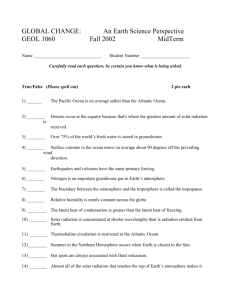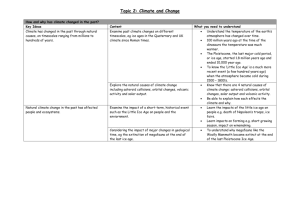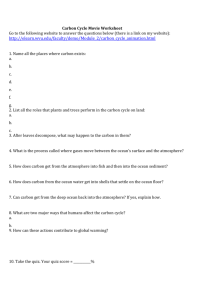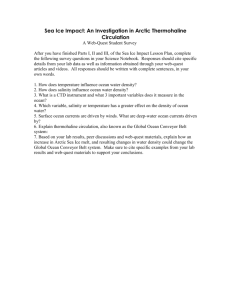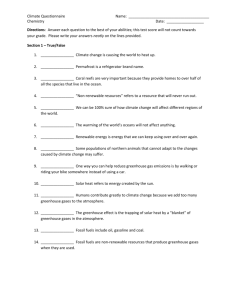SCIENCE & TECHNOLOGY Secondary 4 Study Guide - 2013-2014
advertisement
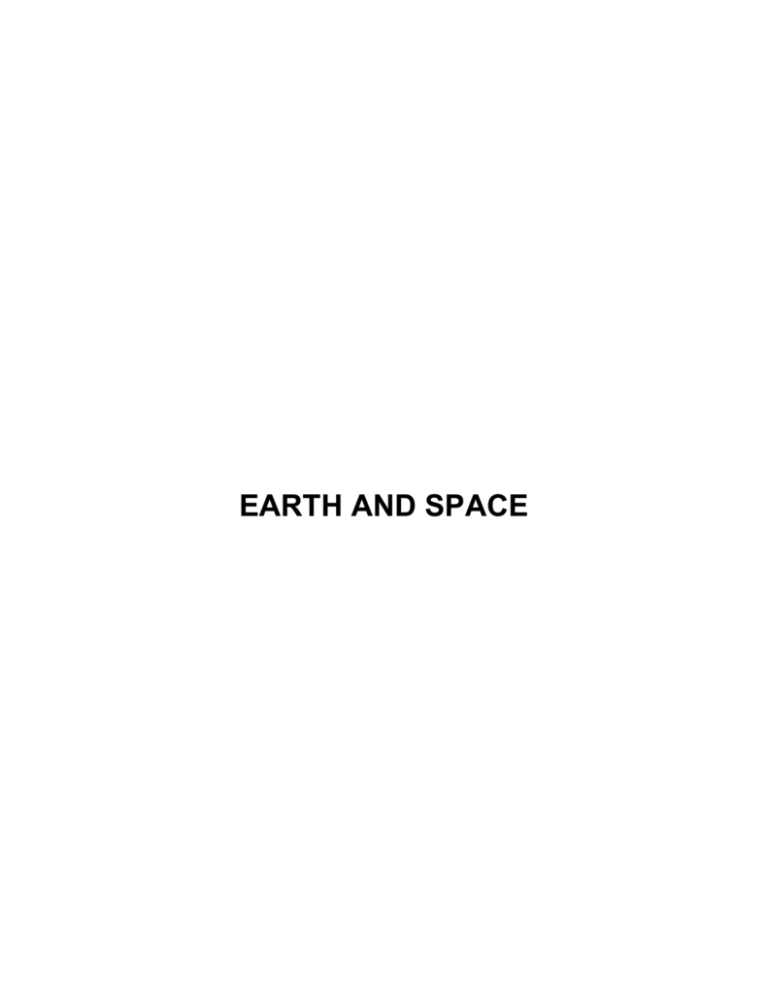
EARTH AND SPACE Lithosphere: Permafrost I can define permafrost as ‘a layer of permanently frozen soil’. Explanation of Concepts Permafrost is a layer of permanently frozen soil (2 years or more), found in the polar regions and/or high altitudes. In some areas, the top layer of the permafrost, called the active layer, thaws only in the summer. The lower layer remains frozen. Plants can grow during this short period of time. Building homes in areas of permafrost can be challenging since they can become unstable during periods of thaw if they are built on the active layer. Placing the foundation on frozen soil, below the active layer, can prevent the problem Questions 1. Which of the following statements correctly describes permafrost? A) All the frozen water on the Earth’s surface. B) A layer of soil frozen for more than two years. C) The snow which accumulates on the surface of glaciers. D) The upper layer of water which freezes when in contact with cold air. Answer: 1. B Earth and Space Page 18 Version 2 Lithosphere: Permafrost I can explain and interpret some of the consequences of a rise in temperature in the permafrost. Explanation of Concepts The rise in temperature associated with global warming affects the permafrost. With warmer temperatures, the depth of the active layer increases (more of the soil thaws during the summer) and the amount of time the active layer is thawed. The consequences of melting permafrost include: • The land above it sinks or changes shape. Sinking land can damage buildings and infrastructure such as roads, airports, and water and sewer pipes. • Soil is more vulnerable to erosion. Sediments can accumulate in rivers, the rivers can become shallower, impacting the plant and animal life in the rivers. • Landslides can occur because the melted soil slips off the frozen layer underneath. • Carbon dioxide and methane are released to the atmosphere leading to the intensification of the greenhouse effect. (When the permafrost melts, the organic matter in it decomposes, releasing carbon dioxide and methane.) • The type and number of plant species growing on the soil may change. • Due to greater access to nutrients and a longer and warmer growing season, primary productivity will increase. Questions 1. Which of the following is a consequence of melting permafrost? A) Increased primary productivity B) Decreased erosion C) Decreased levels of greenhouse gases D) Decreased decomposition of organic matter in soil 2. How does the melting of permafrost lead to higher average global temperatures? Earth and Space Page 19 Version 2 3. What impact does the melting permafrost have on human settlements? 4. Global temperatures have been increasing at a steady rate. Ecologists have been hired to study the impact of increasing temperature s on a region in Northern Quebec. Which graph below correctly shows the consequence of a rise of temperature in the region? Explain your answer. Graph A Graph B Answers 1. A 2. The melting of permafrost releases additional methane which increases the greenhouse effect even more. 3. Buildings that are built on the permafrost become unstable and landslides occur. 4. Graph A. As temperatures rise, permafrost melts and releases CO2 and CH4 that is stored in the frozen ground. Earth and Space Page 20 Version 2 Biogeochemical Cycles I can describe transformations related to the circulation of carbon in the environment. I understand the role that photosynthesis and respiration play in the carbon cycle. Explanation of Concepts Carbon is an element found in the environment in many different forms. Examples of Carbon in the Environment Example Sphere Biosphere Part of the tissues of living organisms Atmosphere In the form of various gases (e.g. carbon dioxide:CO2; methane:CH4) Hydrosphere Dissolved in water (e.g. in oceans and lakes) Lithosphere Found in skeletons (calcium carbonate: CaCO3), carbonate rocks, fossil fuels (oil, coal and gas) Through various chemical reactions, carbon cycles through parts of the environment. It is transformed from simple to more complex forms, and vice-versa. Examples of the Transformation of Carbon in our Environment From To Atmosphere Biosphere Atmosphere Hydrosphere CO2 dissolves in water. Biosphere Atmosphere CO2 is returned to the atmosphere through cellular respiration of consumers, forest fires, etc. CO2 and CH4 are produced by the decomposition of plant and animal wastes. Hydrosphere Lithosphere CO2 dissolved in water in the form of CaCO3 becomes part of shells and skeletons. It can then convert to carbonate rock or form fossil fuels. Lithosphere Atmosphere Carbon rock can release CO2 during volcanic eruptions. Burning of fossil fuels releases CO2. Earth and Space Action Photosynthesis: CO2 is converted into glucose, C6H12O6. Consumers eat producers and carbon thus circulates within the biosphere. Page 21 Version 2 The Carbon Cycle Questions 1. Which of the following processes does not cycle carbon dioxide (CO2) back into the atmosphere? A) Photosynthesis B) Decomposition of waste C) Forest fires D) Volcanic eruptions Earth and Space Page 22 Version 2 2. The carbon cycle describes the movement of carbon throughout the biosphere. Some human activities can have an impact on the carbon cycle through either the production of excess carbon dioxide gas, CO2, or through decrease in the production of carbon dioxide. Which of the following human activities will increase the amount of CO2 in the atmosphere? Explain your answer. a) A tree-planting initiative in the Boreal forest. b) Deforestation by a logging company Answers 1. A 2. Activity B: Deforestation will increase the amount of carbon dioxide in the atmosphere. Trees take in carbon dioxide through photosynthesis; deforestation will lead to an increase in CO2 levels. Earth and Space Page 23 Version 2 Hydrosphere: Catchment Area I can define a catchment area as ‘a territory surrounding a waterway’. Explanation of Concepts Precipitation falls on the surface of the Earth, accumulates in streams, and infiltrates the ground. The natural slope of the land causes water to flow into rivers and accumulate in larger reservoirs, such as a lake. All the area from which water empties into the same large body of water is called a catchment area or watershed. The boundaries of a catchment area are usually defined by natural high ground, such as a hill or peak. A Catchment Area Questions 1. Which of the following does not affect the flow of water into a catchment area? A) Depth and latitude of the water reservoir B) Industrial and urban development C) Shape and slope of the terrain D) Density and diversity of the vegetation Earth and Space Page 24 Version 2 2. Which location is in the same catchment area? A) 1 and 2 only B) 1 and 3 only C) 2 and 3 only D) 2 and 4 only Answers 1. A 2. C Earth and Space Page 25 Version 2 Hydrosphere: Catchment Area I can describe and interpret some of the impacts of human activity on the waterways in a catchment area. Explanation of Concepts Human activity which impacts waters will not only affect the immediate area, but also the area downstream of the disturbance. For example, excess fertilizer from a farm can seep into the soil and be washed into a river. The river is part of a catchment area and downstream of the farm will also be contaminated with the fertilizer. Locations upstream from the farm will not be affected. Water pollution can therefore spread hundreds of kilometers from its original source. Questions 1. Which of the following activities has the greatest impact on the flow of water in a catchment area? A) Filling up a child’s swimming pool with 40 L of water. B) Treating drinking water for a city in a municipal water treatment plant. C) Rerouting rivers for the construction of a hydroelectric dam. D) Repairing a bridge connecting Montreal’s South Shore to the Island of Montreal. Earth and Space Page 26 Version 2 2. An inspector for a town of has noticed that the wastewater for the A2A carwash has been flowing into a nearby stream. The inspector informed the A2A carwash owners that they would be fined since they were polluting the town’s water source. Use the map of the town’s watershed below to explain whether the inspector was correct in fining the carwash. Explain your answer. A2A Car Wash Water Filtration Plant Town Answers 1. C 2. The inspector was correct. The A2A carwash and the town’s filtration plant are in the same catchment area (watershed). Since the A2A car wash is above the filtration plant, any wastewater it produces will flow downstream and enter into the river used to supply the town with drinking water. Earth and Space Page 27 Version 2 Hydrosphere: Salinity I can define salinity as ‘a measure of the quantity of salt in a solution’. Explanation of Concepts The concentration of salt in a solution is defined as its salinity. Water in oceans is saline because salts from the lithosphere are dissolved in it. Near the equator, ocean water has a higher salinity. Water evaporates at a greater rate due to high temperatures, creating a higher salt content. Near the polar regions, ocean water has a lower salinity than near the equator. The fresh water (found in pack ice and glaciers) enters the oceans diluting the salt water, reducing its salinity. Questions 1. From the statements below, choose two which will cause an increase in the salinity of ocean water. 1. increased erosion 2. ocean water redirected to a tidal energy plant 3. ice floes and glaciers melt 4. water evaporates at the equator A) 1 and 3 Earth and Space B) 1 and 4 C) 2 and 3 Page 28 D) 2 and 4 Version 2 2. Samples of ocean water were collected from different depths and analyzed. Sample Mass of Salt Volume of Sample A 8.32 g 240 mL B 7.65 g 0.225 L C 4.20 g 115 mL Rank these samples in order of increasing salinity. Show your work. Answers 1. C 2. The higher the concentration of salt in the ocean water, the greater the salinity. c= m/V Solution A: mass = 8.32 g volume= 240 mL = 0.240 L c=8.32 g/0.240 L c= 34.7 g/L Solution B mass = 7.65 g volume= 0.225 L c=7.65 g/0.225 L c= 34.0 g/L Solution C: mass =4.20 g volume= 115 mL = 0.115 L c=4.20 g/0.115 L c= 36.5 g/L The samples in order of increasing salinity are: B, A, C. Earth and Space Page 29 Version 2 Hydrosphere: Salinity I can describe the influence of salinity on the density of a solution. Explanation of Concepts A solution with more salt dissolved in it will have a higher salinity and also a higher density. A solution with less salt dissolved in it will have a lower salinity and also a lower density. Therefore freshwater is less dense than ocean water Questions 1. Which of the following will increase the density of a solution? 1. Increasing the salinity 2. Decreasing the salinity 3. Adding water 4. Allowing water to evaporate A) 1 only B) 1 and 2 C) 1 and 3 D) 1 and 4 2. Does the density of the ocean water increase or decrease as glaciers and pack ice melt? Explain your answer. Answers 1. D 2. The density of the ocean water decreases. Glaciers and pack ice are made of fresh water. When they melt, it decreases the salinity. Earth and Space Page 30 Version 2 Hydrosphere: Ocean Circulation I can describe the factors that affect the circulation of surface currents and deep currents. Explanation of Concepts The water in oceans is in constant movement due to ocean circulation. This is the combination of water movement due to surface currents, subsurface current, and the rotation of the Earth. Surface currents carry water as deep as 400 m and are caused by wind. They generally move water across the Earth horizontally. Subsurface currents are caused by the density of water. The density is affected by two factors: • • the salinity of water the temperature of the water Salty and cold water is denser, therefore has a tendency to sink. Less salty and warm water is less dense, and has a tendency to rise. These movements create subsurface currents. Earth and Space Page 31 Version 2 Questions 1. Different factors can affect the circulation of surface currents and deep currents in the ocean. 1. Temperature differences in the water 2. Air pressure differences in the atmosphere 3. Differences in the waters’ salinity 4. The rotation of the Earth 5. The depth of the water Which of the factors above only effect surface currents? A) 1 and 3 only B) 2 and 4 only C) 1, 3 and 5 D) 2, 4 and 5 2. What are the characteristics of ocean water which has a tendency to sink? A) Low temperature and low density B) Low temperature and high density C) High temperature and low density D) High temperature and high density 3. On Monday, a high pressure system resides over the middle of the Atlantic Ocean; it is calm and sunny. On Thursday, several low pressure systems merge to create a powerful storm with strong winds and heavy rain. Describe the differences in oceanic circulation in this area on Monday and Thursday. Answers 1. B 2. A 3. Thursday Surface Current Increase in wind causes more surface currents Subsurface Current The storm may mix up water, slightly alter, in that location, the temperature and salinity, which will eventually return to normal. Earth and Space Page 32 Version 2 Hydrosphere: Ocean Circulation I can describe the role of thermohaline circulation on global climate regulation. Explanation of Concepts The combination of surface and subsurface currents results in thermohaline circulation. It functions like a conveyor belt which moves warm and cold water around the Earth. • In the polar regions, cold surface water sinks to the bottom of the ocean floor and travels along the ocean floor • When it gets to warmer regions (such as the equator) the water is heated and rises back up to the surface and then warm water travels along the surface towards • When it gets to the Polar Regions, the warm water gets cooled once more and the process repeats itself. Thermohaline circulation regulates temperatures, preventing extreme cold at the poles and extreme heat around the equator. For example, the Gulf Stream originates near the equator on the Atlantic Coast of Central America and carries warm water up the coast, releasing its heat into the atmosphere, past Quebec and Labrador. Earth and Space Page 33 Version 2 Questions 1. Which of the following statements concerning thermohaline circulation is true? A) Thermohaline circulation allows for the heat accumulated in ocean water at the Polar Regions to circulate to the Equatorial Region. B) Thermohaline circulation allows for the heat accumulated in ocean water at the Equatorial Region to circulate to the Polar Regions. C) Thermohaline circulation can be compared to a conveyor belt which moves warm and cold air masses around the Earth. D) Thermohaline circulation can be compared to a conveyor belt which moves warm and cold freshwater systems around the Earth. 2. The Labrador Current flows south along the coast of Newfoundland and Labrador. The water it carries is so cold that it keeps the most northern regions icebound in winter. The Labrador Current carries cold water towards the Atlantic Ocean where it will mix with the Gulf Stream. The Gulf Stream brings warm water up along the eastern coast of the U.S.A. and carries it towards Western Use your knowledge of thermohaline circulation to explain why Stornoway has milder winters than Hopedale although they are at similar latitudes. Earth and Space Page 34 Version 2 Answers 1. B 2. Thermohaline circulation is the movement of water around the Earth. As the warm water of the Gulf Stream current circulates upwards towards Stornoway, it releases its heat to the environment; creating a relatively mild winter. As the cold water of the Labrador current descends towards Hopedale, it does not have the same warming effect as the Gulf Stream current. Earth and Space Page 35 Version 2 Hydrosphere: Glacier and Pack Ice I can explain the differences between glaciers and ice floes. Explanation of Concepts Formation Glacier Pack Ice • Formed as a slow sliding mass of ice is formed on land due to the accumulation of snow on top of it. • Formed on the surface of the ocean due to cold temperatures which freeze the top layer of the water. • As snow accumulates on top of the glacier, the layers below are compacted and form ice. • As the ocean water freezes, the salt is eliminated. • As the glacier slides, some of the ice gets pushed out its sides and breaks off. It falls into the ocean in large chunks and forms icebergs. • These slabs of ice are transported by the wind and accumulate throughout the winter months. Content • Fresh water • Fresh water Location • On land • Mountainous areas and polar regions • On every continent • On ocean water • Only polar regions Questions 1. Which of the following is true about glaciers and pack ice? A) Both glaciers and pack ice are formed on land. B) Both glaciers and pack ice are formed on the ocean’s surface. C) Both glaciers and pack ice contain freshwater. D) Both glaciers and pack ice form icebergs. Earth and Space Page 36 Version 2 2. Which of the following statements is true about pack ice? A) The melting of pack ice affects the salinity of the ocean water. B) The melting of pack ice does not affect the temperature of the ocean water. C) The melting of pack ice affects sea levels. D) The melting of pack ice does not affect oceans. Answers 1. C 2. A Earth and Space Page 37 Version 2 Hydrosphere: Glacier and Pack Ice I can describe the impacts of the melting of glaciers and ice floes. Explanation of Concepts Impact of Melting Glaciers • Increase in sea level Due to global warming, the ice on the surface of glaciers melts, seeps to the bottom, and causes the glacier to slide more quickly. As more and more pieces of the glacier break off, icebergs fall into the ocean and raise the sea level. In addition, as glaciers melt, more fresh water is added to the ocean. Both these events can cause flooding. • Slowing of thermohaline circulation As more pack ice melts, fresh water dilutes the salty water, causing a decrease in the density of the ocean water. The water has less of a tendency to sink, thus slowing thermohaline circulation. This can affect global climate. Impact of Melting Pack Ice • Loss of habitat Animals living in the arctic rely on pack ice for their survival. Global warming, which has greatly reduced the area of pack ice on Earth, puts pressure on certain species, such as polar bears and seals, due to habitat loss. • Slowing of thermohaline circulation As more pack ice melts, fresh water dilutes the salty water, causing a decrease in the density of the sea water. The water has less of a tendency to sink, thus slowing thermohaline circulation. This can affect global climate. Note: Ocean levels do not increase when pack ice melts. Earth and Space Page 38 Version 2 Questions 1. Which of the statements below correctly identifies the effect of the increase in the melting of pack ice due to climate change? A) Loss of habitat for arctic species B) Rise in the sea level C) Increase in the number of icebergs D) Flooding of low lying areas 2. Global warming has caused the melting of pack ice at the North and South poles. Explain how this affects the salinity and density of the water in those regions. How does this impact thermohaline circulation? 3. Explain how a population living at sea level near the equator can be affected by global warming at the Poles. 4. Why is flooding not a result of the increased melting of pack ice? Answers 1. A 2. As the pack ice melts, more fresh water is introduced into the ocean. This dilutes the salty water, decreasing its salinity. Lower salinity also means lower density. Since the water no longer sinks as easily, thermohaline circulation is slowed. 3. As glaciers melt ocean levels rise because water is added to the ocean as well as icebergs (which were not there before). The increased ocean level affects low lying areas around the world and can cause flooding even as far away as the equator. 4. Pack ice is formed from water already in the ocean. Ice has a higher volume for the same amount of water, but only 90% of it is below the surface Earth and Space Page 39 Version 2 Atmosphere: Greenhouse Effect I can describe the greenhouse effect. Explanation of Concepts The greenhouse effect is a natural phenomenon which helps keep the air around us warm and stable. The Sun’s rays hit the Earth and are absorbed by the ground. The heated ground then emits infrared rays. Some of these rays pass through the atmosphere, into space. Some are trapped in the Earth’s atmosphere with the help of gases such as carbon dioxide (CO2), methane (CH4), and nitrogen oxides (NOX). The greenhouse effect can be intensified by human activities that release greenhouse gases such as burning fossil fuels and large scale farming. Earth and Space Page 40 Version 2 Questions 1. Which of the following gases do not contribute to the greenhouse effect? A) CO2 B) CH4 C) NO2 D) SO2 2. Which of the following statements about the Greenhouse effect is true? A) An increase in greenhouse gases in the atmosphere leads to an increase in the amount of heat that escapes into space. B) A decrease in greenhouse gases in the atmosphere leads to an increase in the amount of heat that escapes into space. C) An increase in greenhouse gases in the atmosphere leads to an increase in the amount of solar radiation that will enter the atmosphere. D) A decrease in greenhouse gases in the atmosphere leads to an increase in the amount of solar radiation that will enter the atmosphere. 3. Explain how the greenhouse effect is essential for life on Earth. Answers 1. D 2. B 3. Greenhouse gases are necessary to keep the temperature and the climate around Earth stable. By trapping some of the sun’s rays reflected of the surface of the Earth, the atmosphere around us remains warm and stable, necessary for sustaining life. Earth and Space Page 41 Version 2 Atmosphere: Greenhouse Effect I can explain and interpret some of the consequences of a higher concentration of greenhouse gases. Explanation of Concepts The concentration of greenhouse gases in the atmosphere has been relatively constant for thousands of years, primarily through the balance created by the carbon cycle. Recently, human activity (especially the burning of fossil fuels and farming) has produced an unnatural increase in the concentration of greenhouse gases. This means that more heat is trapped in the atmosphere, causing global warming and climate change. Global warming can lead to the melting of pack ice and glaciers. As the temperature of the ocean increases, species which are sensitive to even slight changes in temperature variations, for example corals, can die. An entire ecosystem of aquatic organisms depends on a thriving coral community and can be disturbed by a loss of habitat. Climate change also causes precipitation patterns and wind patterns to change. Questions 1. Five human activities are listed below. 1. Raising cattle 2. Driving a gasoline powered car 3. Using a natural gas fireplace 4. Walking 5. Swimming in a lake Which of the above activities could contribute to the greenhouse effect? A) 1 and 2 only Earth and Space B) 1, 2 and 3 C) 2 and 3 only Page 42 D) 4 and 5 only Version 2 2. Which of the following does not contribute to the formation of greenhouse gases? A) Decomposition of waste in landfills B) Burning of fossil fuels C) Melting of the permafrost D) Photosynthesis in plants 3. The National Center for Policy Analysis released a newsletter in June 2009 highlighting “10 Cool Global Warming Policies”. Two of the proposed policies for reducing the harm of global warming were: Policy 1: Reduce forest wildfires through Alternative Forest Management Institutions Policy 2: Subsidise the development of renewable energy resources Explain how each policy could reduce global warming. Answers 1. B 2. D 3. Policy 1: As the photosynthesis of plants consumes carbon dioxide, the destruction of forests by forest fires will reduce the amount of CO2 that is consumed from the atmosphere. The burning of the forests releases CO2 to the atmosphere. So if forest fires are reduced, there will be less CO2, a greenhouse gas, released to the atmosphere and more CO2 consumed by the trees. With less greenhouse gas in the atmosphere, global warming could be reduced. Policy 2: Renewable energy resources such as wind and solar do not produce greenhouse gases whereas non-renewable such as fossil fuels, do. Earth and Space Page 43 Version 2 Renewable and Non-Renewable Energy Resources I can describe technologies used to produce electricity using the energy resources in the lithosphere, hydrosphere and atmosphere. Explanation of Concepts Lithosphere Energy Source Description • Produced when animal and plant residues accumulate on the sea floor and gradually get covered by layers of sand and rock. Over millions of years, they are transformed into oil and natural gas. • Humans mine fossil fuels and burn them to produce thermal energy, which can also be converted into mechanical and electrical energy. • The burning of fossil fuels releases pollutants such as carbon dioxide (CO2) and methane (CH4). Other gases, such as sulfur dioxide (SO2) and nitrogen oxides (NOX) are also released. • Uranium is a radioactive element and exists naturally in the lithosphere. • Nuclear power plants use mined uranium to transform thermal energy into mechanical and electrical energy. • A small amount of radioactive material produces a lot of energy • Nuclear waste is another by-product and needs to be buried since it continues to release radioactivity for hundreds of years • Below the lithosphere lies hot magma which releases thermal energy. Harnessing this energy is called geothermics. • A fluid is circulated into the ground; it is heated naturally, then brought up to the surface. The hot liquid can be used to heat homes or its thermal energy can be transformed into electrical energy. • It can be difficult to access geothermal energy. It can also be very expensive. Fossil Fuels Uranium (Nuclear) Geothermal Earth and Space Page 44 Version 2 Hydrosphere Energy Source Hydroelectric Description • Hydroelectric power plants use the movement of falling water to spin turbines which are located inside dams built across a river. • Water falling through a dam spins a turbine that converts mechanical energy into electrical energy. • Hydroelectricity is the main source of energy in Quebec. • Wave energy is produced when the energy contained in the movement of water is harnessed using buoys, which rise and fall with the waves. • Ocean currents are able to spin underwater turbines, which are similar to wind turbines. The mechanical energy produced by the movement of the buoys and blades can be converted into electrical energy. • Harnessing energy from waves and ocean currents is not yet widespread due to the fact that they are, at the moment, too expensive. • Electricity can be generated from tides when water from a high tide is collected (sometimes using a dam) and then falls through turbines converting mechanical energy into electrical energy. • A tidal range of 5 m is necessary to use this technology. Wave and Ocean Current Tidal Atmosphere Energy Source Wind Earth and Space Description • The wind causes the turbines to rotate and a generator converts the mechanical energy into electrical energy. • Wind energy cannot be stored; therefore it needs to be used in conjunction with another source of energy. • Wind energy can be unreliable and unpredictable. Page 45 Version 2 Other Energy Source Description • As the rays of the sun hit panels containing photovoltaic cells, they cause electrons to flow, creating current electricity. • This technology is costly and is limited by the amount of sunlight present. Solar Questions 1. Which of the following technologies uses an energy source derived from the lithosphere? A) Tidal barrage B) Wind turbine C) Photovoltaic cell D) Coal-fired plant 2. The lithosphere and the hydrosphere provide us with many different resources that we can use to produce energy. Each resource has its advantages and disadvantages. Complete the following table regarding the advantages and disadvantages of uranium and tidal energy: Resource Uranium Tidal Energy Earth and Space Advantages Disadvantages 1. 1. 2. 2. 1. 1. 2. 2. Page 46 Version 2 3. Wind farms are growing in importance in Quebec. In partnership with Hydro-Quebec, these farms require many years of planning and construction. The Gros-Morne wind park in the Gaspésie region will have over 140 wind turbines at the end of its construction. In order to begin construction of Phase I in the spring of 2010, deforestation work was performed in the fall of 2009. What are the advantages and disadvantages of using wind energy? Answers 1. D 2. Resource Uranium Advantages Disadvantages 1. small quantity of uranium will produce much energy 1. non-renewable form of energy 2. does not produce and greenhouse gases 1. renewable source of energy Tidal Energy 2. tides are predictable; there are 2 high tides and 2 low tides a day 2. produces radioactive waste that is toxic to all organisms 1. turbines can only be used in certain regions where tide height reaches a minimum of 5 meters. 2. turbines are placed in harsh salt water conditions, often far from city centers. 3. Advantages to using wind energy is that it is a renewable, clean (no greenhouse gases) form of energy. Disadvantages to using wind energy are that the wind is not predictable and that the energy itself cannot be stored. Some would say that the wind turbines create both visual pollution, ruining the natural beauty of the environment and noise pollution. Deforestation also needs to take place before some wind parks are constructed. Earth and Space Page 47 Version 2 Renewable and Non-Renewable Energy Resources I can describe the main impact of the use of energy resources in the lithosphere, hydrosphere and atmosphere. Explanation of Concepts There are advantages and disadvantages for using the different types of energy resources. Note: A non-renewable energy source is finite: It will eventually run-out or become so scarce that it is too expensive or environmentally damaging to retrieve. A renewable energy source is constantly replenished and will never run out. Impact of Energy Resources from the Lithosphere Energy Source Renewable or Non-Renewable Environmental Impact • Fossil fuels Non-Renewable • Uranium (Nuclear) • • Non-Renewable • • • Geothermal Earth and Space Renewable The refining and burning of fossil fuels produces atmospheric pollutants, including the greenhouse gases carbon dioxide (CO2, methane (CH4), and nitrogen oxides (NOx). The burning and refining of fossil fuels can also contribute to the production of acid rain. No atmospheric pollutants are released. Nuclear waste is highly toxic and must be stored safely for hundreds of years. Leakage of nuclear materials could have a devastating effect. Low atmospheric pollution compared to fossil fuels. The hot ground water used in geothermal plants contains sulfur, mercury, hydrogen sulfide, arsenic and ammonia. These chemicals can be released in to the water supply, or the atmosphere through steam. Page 48 Version 2 Impact of Energy Resources from the Hydrosphere Energy Source Renewable or Non-Renewable Hydroelectric Renewable Wave Renewable Tidal Renewable Environmental Impact • • • • • • Causes little pollution. The building of dams often floods large areas of land, affecting the habitat of various plant and animal species. May disturb aquatic ecosystems. Does not release atmospheric pollutants. Does not release atmospheric pollutants Tidal barrages (dams) can interfere with fish migration and can affect water flow and levels. Impact of Energy Resources from the Atmosphere Energy Source Wind Renewable or Non-Renewable Renewable Environmental Impact • • • • Does not release atmospheric pollutants. Turbines can produce sound pollution. Can disrupt the visual appeal of the landscape. Birds can collide with the wind turbines. Impact of Energy Resources from Other Energy Source Solar Renewable or Non-Renewable Renewable Environmental Impact • • Does not release atmospheric pollutants. Can disrupt the visual appeal of the landscape. Note: All of these technologies produce electricity by converting mechanical energy into electrical energy except the technology associated with solar energy Earth and Space Page 49 Version 2 Questions 1. A community in Gaspé is researching the environmental impacts of different energy sources. Below is a list of possible environmental impacts 1. Tidal barrages can disrupt marine life. 2. Tidal power plants and coal power plants release greenhouse gases. 3. Nuclear power plants create no harmful waste products. 4. Flooding is a concern in the building of hydroelectric dams. Which of the above statements are true? A) 1, 2 and 3 B) 1, 3 and 4 C) 1 and 4 D) 2 and 3 2. A community in Gaspé is researching the environmental impact of two different energy technologies: a tidal power plant and a coal power plant. For each of the energy resources the community is considering, state: • the energy source as renewable or non-renewable • the main environmental impact for each type of energy Answers 1. C 2. Tidal Power Plant – renewable / tidal barrages can disrupt marine life Coal Power Plant – non-renewable / releases greenhouse gases Earth and Space Page 50 Version 2

